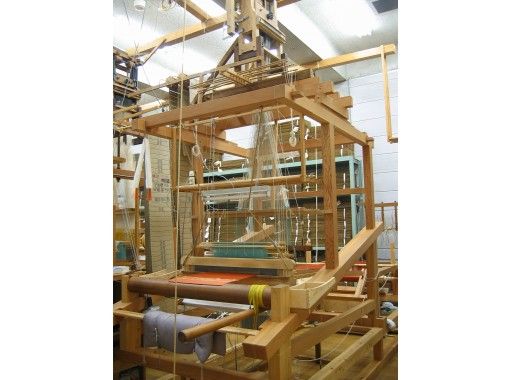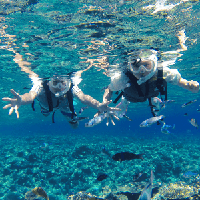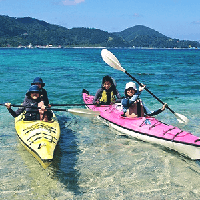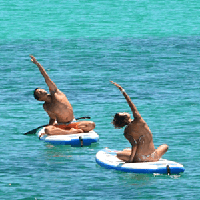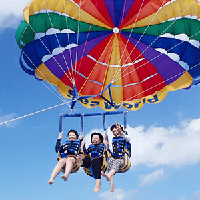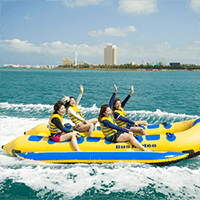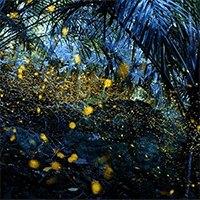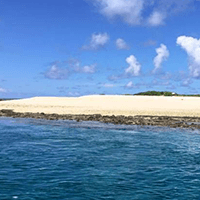Kyoto in Sightseeing tour/Guided tour
- Age 1~Age 70
- Over 6 hours on the day
- 08:40 / 09:50
[08:40] Exit 2 of Nihonbashi (Namba/Shinsaibashi area) [09:50] Kyoto Station Hachijo Exit, sightseeing bus parking lot [11:20] ▼ One of the Three Scenic Views of Japan, "Amanohashidate Observatory" (about 2.5 hours including lunch, own expense) [14:30] ▼ Ine Funaya ~ "Venice of Japan" "Kyoto's last hidden place" ~ (about 1 hour, walk or bike, seagull feeding boat, etc., please pay the boarding fee yourself) [15:30] End of the day's tour and return home. [19:00] Shinsaibashi/Dotonbori area (about 1 hour, free time) Amanohashidate is one of the Three Scenic Views of Japan, along with Matsushima in Mutsu and Miyajima in Aki. It is a sandbar about 3.6 kilometers long, formed by the deposition of the coast. About 8,000 pine trees of various sizes are planted, and white sand beaches stretch on both the east and west sides. It is a special natural landscape. It is called "Amanohashidate" because it looks like a bridge stretching diagonally towards the sky. On Mount Monju, there is an observation deck from which you can see Amanohashidate. The mountain has a Ferris wheel and recreational facilities suitable for all ages. From here, Amanohashidate looks like a dragon flying in the sky, so it is called "Flying Dragon View". From here, you can see the vivid scenery of Amanohashidate. (Cable car ticket is at your own expense: Amanohashidate Observation Deck Cable Car/Monorail Combined Ticket 850 yen) [Ine Village] was selected by the Japanese as one of the "18 Most Beautiful Villages in Japan". With its unique Japanese floating boathouse architecture, you can experience the original ecological landscape that you cannot experience in tourist spots. Even today, people coexist with the sea in front of them. The clear and beautiful sea, the deep green mountains, the rapidly changing colors of the sky, and the colors of the boathouses that represent Japan. These are the pure colors of nature that can only be experienced in Ine Town. The fishing village along the coast is away from the hustle and bustle and is full of simple innocence. You can experience a 25-minute cruise around Ine Bay at your own expense, and you can also feed the seagulls. (Boats depart every hour and 30 minutes. The boarding fee is 1,200 yen for adults and 600 yen for children, at your own expense. A bag of food for the seagulls costs 100 yen. If the tour is cancelled due to wind or waves, you can wander around freely.) Note: There are many eagles living around the Ine Funaya Ya, so please be careful when taking the sightseeing boat. If you see an eagle, stop feeding the seagulls immediately and put away any food you are holding to avoid being pecked by the eagle.
- Age 1~Age 70
- Over 6 hours on the day
- 07:20
07:20 Meet at Exit 2 of Nihonbashi 09:50 ▼Ine Funaya ~ "Venice of Japan" "The most beautiful village by the sea" ~ |Ine Town |Funaya Hiyori | INE COFFEE (about 40 minutes, walk or ride, ride fare at own expense) 11:10 ▼One of the Three Most Scenic Views of Japan "Amanohashidate Observatory" |Chion-ji Temple, Monju-do (Temple for academic success) |Walk and play in the sea (about 2 hours including lunch, expenses at own expense) 14:40 ▼Kyoto Gassho Village ~ Miyama Kayabuki-no-Sato (about 40 minutes, free time) |Let's go to the most beautiful photo spot─the little red postbox |Miyama milk and Miyama ice cream are not to be missed in Miyama 15:20 After a fun day of tour, we headed home. 17:20 Shinsaibashi, Dotonbori area (about 1 hour, free time) [Ine Town] was chosen by the Japanese as one of "18 Most Beautiful Towns in Japan". There are Japanese-style floating boat lodges, where you can experience the original ecological landscape that you cannot experience in tourist spots. About 230 boat lodges are lined up along about 5 kilometers of the south-facing coast of Ine Bay. Currently, it is the town with the largest number of old boat houses remaining in Japan. The people who live in the boat houses still coexist with the sea in front of them. [Amanohashidate] "Amanohashidate" in Miyazu Bay facing the Sea of Japan is one of the special scenic spots known as "Japan's Three Views" along with "Matsushima" in Mutsu and "Miyajima" in Aki. [Miyama Kayabuki-no-Sato] is known as one of Japan's three major remaining thatched roof villages along with Shirakawa-go Gassho Village in Gifu Prefecture and Ouchi-juku in Fukushima Prefecture. Recommended sightseeing spots for free strolls: Funaya Weather - Enjoy the beautiful scenery of Ine Bay while drinking coffee (closed on Wednesdays, free time in Ine Town) Please be careful if you have time to ride a sightseeing boat: There are many eagles living around Ine Funaya, so please be careful when riding a sightseeing boat. If you see an eagle, please stop feeding the seagulls immediately and put away any food you are holding to avoid being pecked by the eagle. This is a shared tour and participants come from all over the world.
- Age 3~Age 80
- Over 6 hours on the day
- 08:00
07:50 Meet in front of Kani Douraku Dotonbori East Branch 08:00 Departure ↓ Kinkaku-ji Temple (approx. 40 minute stay) Admission ticket included ↓ Arashiyama (approx. 120 minute stay) ↓ Miyama Kayabuki-no-Sato (approx. 90 minute stay) ↓ Fushimi Inari Taisha Shrine (approx. 60 minute stay) ↓ Osaka Dotonbori (scheduled arrival around 19:30) *Due to weather or traffic congestion, the stay at the facilities may be shortened or the tour may be canceled.
- Age 9~Age 70
- 3~4 hours
- 09:00 / 09:30 / 13:30 / 14:00
From the start to the finish, you will board a rubber boat through a vast natural ravine, and everyone will work together as a team to overcome this thrilling and thrilling course. In addition to rafting down torrents on a rubber boat, you can also dive into rocks about 3 meters high and swim in the river in gentle areas, which is why it has earned many reviews and reputations. . In order for beginners and those who are not good at swimming to participate with peace of mind, we have prepared a solid safety explanation from the instructor, safety equipment such as life jackets and helmets, and wetsuits that match the season. I'm here. All instructors have taken first aid courses and river rescue courses to prepare for an emergency accident. You can participate in the tour safely and securely. 30 minutes from Kyoto Station with excellent access from the Kansai area. By all means, please spend the most enjoyable holiday with easy Kyoto Hozu River rafting.
- Age 7~Age 100
- 1~2 hours /2~3 hours
- 10:00 / 13:30 / 15:30
This is an approximately 1.5 hour plan where you will experience weaving a 10cm square silk fabric and tour the workshop. You can take your completed work home on the day. Everyone from elementary school students to the elderly can easily weave. Please feel the "texture" of the fabric you have woven yourself. You can see and touch some of Japan's finest works of art, which are world-class, and have a valuable experience learning about their history. *Bonus: Take photos on a restored high aircraft. An original postcard will be presented. You can also go shopping. We have three looms available for the weaving experience. For groups of 4 or more, orders will be given.
初めての機織り体験でした。なかなか機織りが出来る所は少ないのでオススメです。好きな色の糸を選ぶことが出来ました。他にも体験だけでなく歴史や京都の職人さんのお話などとても興味深いお話もして下さいました。英語で説明もあるので外国人の方も来られていました。
- Age 1~Age 70
- Over 6 hours on the day
- 08:40 / 09:50
[08:40] ▼Nihonbashi Station Exit 2 (Namba-Shinsaibashi area) [09:50] ▼Kyoto Station Hachijo Exit (in front of 7-Eleven) [10:30] ▼Kinkaku-ji Temple (about 40 minutes) Visiting fees are at the customer's expense. [12:00] ▼Kiyomizu-dera area (individuals visit, stroll freely, lunch on their own / about 3.5 hours) [15:20] ▼Fushimi Inari Taisha Shrine (about 70 minutes) [16:50] ▼After enjoying the day's itinerary, we start to return. [18:10] ▼Shinsaibashi, Dotonbori area (free stroll / about 1 hour) ▼The original name of Kinkaku-ji Temple is Rokuon-ji Temple. It is also called "Kinkaku-ji Temple" because the exterior walls of the Shariden Hall, the central building of the temple, are all decorated with gold leaf. The temple was built in 1397. Originally a villa for Shogun Ashikaga Yoshimitsu (the prototype of Shogun Yoshimitsu in the anime "Kei Ikkyu-san"), it was later converted into the Zen temple "Bosatsurei". If you visit Kinkaku-ji Temple during the autumn foliage season, the golden tower and the red autumn leaves covering the mountain create a spectacular view. (Admission fee: 500 yen for adults, 300 yen for elementary and junior high school students) ▼ Recommended courses around Kiyomizu-dera Temple Recommended course 1: Kiyomizu-dera Temple (admission fee is at your own expense) - Ninenzaka - Ishibekoji - Gion - Hanamikoji - Yasaka Shrine (You can visit several tourist spots according to your preferences and physical condition) Recommended 2: Kimono experience. Interested guests can wear a kimono, stroll through the old streets, visit Kiyomizu-dera Temple, and leave the most beautiful moments. (There are many kimono shops at Kiyomizu-dera and Fushimi Inari Shrine, and you can choose where to return the kimono. We recommend renting at Kiyomizu-dera and returning at Fushimi Inari. You will be responsible for the cost.) ▼ Fushimi Inari Taisha is famous for its thousand torii gates, and many tourists from both Japan and abroad visit it every year. It was ranked number one for three consecutive years as "Japan's most popular tourist spots for foreigners" in a survey conducted by the world's largest travel site. Let's pray for ourselves and our loved ones here. This is a mixed tour, and participants come from all over the world.
- Age 20~Age 99
- 2~3 hours /3~4 hours
- 13:00
Blessed with an abundance of underground water veins that spring up from the Momoyama Hills, Fushimi was once called "Fushimizu" (literally "fushimizu" in Japanese), and it is said that full-scale brewing began here about 400 years ago because the water was suitable for sake brewing. It flourished as a castle town and a port on the Yodo River on the Tokaido, and sake breweries with white walls stand out along the Uji River and canals. The streets of Fushimi, where you can enjoy the atmosphere of a sake brewing town, with ten-koku boats sailing among swaying willows, have been designated as the "Fushimi Minamihama Neighborhood Landscape Development District" by Kyoto City. ~Time Schedule~13:00 [Meet at the north ticket gate of Keihan Electric Railway Nakashojima Station] Meet in front of the sake barrel object located immediately after exiting the north ticket gate! This is where the tour begins! It's a flat road, but you'll be walking about 2 kilometers, so please wear comfortable shoes on the day. 13:15 [Gekkeikan Okura Sake Museum] ☆Three types of sake tastings, including Daiginjo, and a special Gekkeikan sake cup included☆The building is a wooden storehouse built in the Meiji era that is still in use. You can drink the underground water used in sake brewing from the well in the courtyard. Just like Fushimi sake, it is very soft and delicious, so please try it. You will be surprised at how soft it is. In the exhibition room, you can see traditional sake brewing tools, which are designated as tangible folk cultural properties of Kyoto City. 13:50 [Fushimi Yume Hyakushu] ☆Winter limited sake ice cream included☆Shop & cafe "Fushimi Yume Hyakushu". In fact, this building is the former main store of Gekkeikan, built in the Taisho era. In addition to Gekkeikan, various Kyoto sakes and souvenirs are sold in the store. We have prepared a 3-type sake tasting set including appetizers here. 14:30 [Kizakura Kappa Country] ☆Kyoto's oldest local beer included☆ Kiizakura is famous for its sake commercials using kappa characters, but it is also the first company to make local beer in Kyoto. Therefore, in addition to the sake manufacturing process, Fushimizugura is characterized by the fact that you can tour the beer factory. After the tour, try tasting sake and beer in the lovely courtyard. 15:15 [Aburacho] ☆Authentic sake tasting set of three types☆ We have more than 80 types of sake from all 18 breweries in Fushimi, mainly ginjo sake and daiginjo sake, and more than 100 types including seasonal limited edition sake. In addition, at the sake tasting counter attached to the store, you can compare three types in small cup size as well as a glass. Just looking at the bottles will make you feel happy.
- Age 1~Age 70
- Over 6 hours on the day
- 07:30
07:30-08:30: Pick-up/drop-off/transfer to hotel/private inn Hotels/private inns within the Osaka Loop Line 10:00 ▼ Kiyomizu-dera area (individual worship, free stroll, free lunch/approximately 3 hours) Recommended sightseeing course Course 1: Kiyomizu-dera (customer pays admission fee) - Ni-san-nen-zaka - Ishibe-koji - Gion·Hanami-koji-dori - Yasaka Shrine You can visit your favorite spots according to your stamina and time~Course 2: Kimono experience (Customers who are interested can wear a kimono and enjoy the old townscape and touring Kiyomizu-dera Temple. Let's take pictures of the wonderful moment.) (There are many kimono shops near Kiyomizu-dera Temple and Fushimi Inari Taisha Shrine. We recommend renting a kimono at a shop at Kiyomizu-dera Temple and returning it at a shop at Fushimi Inari Taisha Shrine. The fee is at the customer's expense.) 13:30 ▼ Fushimi Inari Taisha Shrine (individual visit and free stroll / about 70 minutes) 16:00 ▼ Nara Park (individual visit and free stroll / about 1.5 hours) "Deer and autumn leaves" interweave "Nara Park" The contrast between the autumn leaves and evergreen trees is vivid Recommended tourist spot [Todaiji Temple] (Admission fee is at the customer's expense.) Todaiji Temple was built during the Nara period. Nara is popular with tourists and once served as the capital of Japan. It is registered as a World Heritage Site as one of the "Cultural Monuments of Ancient Nara" by UNESCO. Todaiji Temple has eight national treasure buildings, 14 buildings with 24 national treasure Buddha statues, and nine other national treasures, including paintings and books. The famous Great Buddha, the Great South Gate, the Kongorikishi statues, and the Hokkedo Hall, as well as the Buddha statues enshrined within, are all national treasures. There are very few places in Japan where you can see so many national treasures at once. Admission fees: Todaiji Temple Great Buddha Hall: 600 yen for adults (junior high school students and above), 300 yen for elementary school students; Great Buddha Hall and Todaiji Museum: 1000 yen for adults (junior high school students and above), 400 yen for elementary school students 17:30▼After a fun day of sightseeing, we start to head back. 18:30Shinsaibashi, Dotonbori area (Guests on the course that takes you to your hotel or guesthouse should wait for the shuttle bus. When the shuttle bus arrives, we will take you back to your hotel or guesthouse and the tour will end.)This is a mixed tour, and participants come from all over the world.
- Age 1~Age 70
- Over 6 hours on the day
- 08:40 / 09:50
[08:40] Exit 2 of Nihonbashi (towards Namba-Shinsaibashi) [09:50] Kyoto Station Hachijo Exit, sightseeing bus parking lot [10:30] ▼ Sanzenin Temple (approx. 120 minutes, free time, including lunch, please pay your own expenses) [13:30] ▼ Arashiyama (approx. 3 hours, free time) [16:30] We finished our day's tour with a lot of fun and headed home. [17:50] Shinsaibashi/Dotonbori area (approx. 1 hour, free time) Recommended restaurants near Sanzenin Temple: Keibisakan mainly serves soba, tofu dishes, and creative cuisine. Ippukuchaya Main menu: Udon, soba, bowls Ryokawachaya Main menu: Udon, yuba dishes Shinomatsumon mainly serves Kyoto cuisine, tofu dishes, and yuba dishes. Recommended route in Arashiyama (at your own expense. We recommend you choose a tour)1. Sagano train (recommended route: Sagano - Kameoka Station - Sagano)Travel period: March 1st to December 29th (trains do not operate in January and February due to winter maintenance)Closed: Wednesdays (train ticket price is not included, must be purchased separately)Cherry blossom season and autumn leaves season (Arashiyama train, operation date undecided) 1 train 30 seats2. Sagano Bamboo Forest PathSagano Bamboo Forest is located in Arashiyama. The bamboo forest path is about 500 meters long. Pass Nonomiya Shrine and head towards Okawachi Sanso to reach the Arashiyama Bamboo Forest. Walking through the bamboo forest, you can hear the natural sound of the wind blowing through the bamboo leaves. This sound has also been selected as one of the "100 Sounds of Japan that Should Be Preserved". This is also where Ang Lee shot Crouching Tiger, Hidden Dragon. Tenryu-ji Temple on the trail offers a spectacular view of a Japanese garden. The Arashiyama Lantern Festival, held every December, illuminates the bamboo forest and Togetsukyo Bridge with dazzling lights, creating a wintery sight. This is a shared tour, and participants come from all over the world.
- Age 1~Age 70
- Over 6 hours on the day
- 08:40 / 09:50
08:40 ▼ Nihonbashi Station Exit 2 (Namba-Shinsaibashi area) 09:50 ▼ Kyoto Station Hachijo Exit (in front of 7-Eleven) 10:00 ▼ Kiyomizu-dera area (individuals can visit, stroll around freely, and have lunch at their leisure / approx. 3 hours) Recommended sightseeing course Course 1: Kiyomizu-dera Temple (customers are responsible for admission fees) - Ni-Sannenzaka - Ishibekoji - Gion·Hanamikoji-dori - Yasaka Shrine You can visit your favorite spots according to your stamina and time~Course 2: Kimono experience (Customers who are interested can wear a kimono and enjoy the old townscape and touring Kiyomizu-dera Temple. Let's take pictures of the wonderful moment.) (There are many kimono shops near Kiyomizu-dera Temple and Fushimi Inari Taisha Shrine. We recommend renting a kimono at a shop at Kiyomizu-dera Temple and returning it at a shop at Fushimi Inari Taisha Shrine. The fee is at the customer's expense.) 13:30 ▼ Fushimi Inari Taisha Shrine (individual visit and free stroll / about 70 minutes) 16:00 ▼ Nara Park (individual visit and free stroll / about 1.5 hours) "Deer and autumn leaves" interweave "Nara Park" The contrast between the autumn leaves and evergreen trees is vivid Recommended tourist spot [Todaiji Temple] (Admission fee is at the customer's expense.) Todaiji Temple was built during the Nara period. Nara is popular with tourists and once served as the capital of Japan. It is registered as a World Heritage Site as one of the "Cultural Monuments of Ancient Nara" by UNESCO. Todaiji Temple has eight national treasure buildings, 14 buildings with 24 national treasure Buddha statues, and nine other national treasures, including paintings and books. The famous Great Buddha, the Great South Gate, the Kongorikishi statues, and the Hokkedo Hall, as well as the Buddha statues enshrined within, are all national treasures. There are very few places in Japan where you can see so many national treasures at once. Admission fees: Todaiji Temple Great Buddha Hall: 600 yen for adults (junior high school students and above), 300 yen for elementary school students; Great Buddha Hall and Todaiji Museum: 1000 yen for adults (junior high school students and above), 400 yen for elementary school students 17:30▼After a fun day of sightseeing, we start heading back. 18:30▼Shinsaibashi, Dotonbori area (free time/about 1 hour)This is a mixed tour, and participants will come from all over the world.
- Age 3~Age 100
- 1 Day or more
- 18:00
Nogawa Nature School will advance to Kansai. This tour will be hosted by Ryo from the Tokyo school and staff member Muro from Kyoto. Meet at Kyoto Station, and reserve a business hotel for each person. This is a car-only trip to the river. The next day, we will depart at 7:00 and search for Japanese pond turtles in the Lake Biwa water system. The main focus of the Kyoto tour is observing the giant salamander, a natural monument. In addition, we will guide you to several points in Kyoto and capture aquatic insects, amphibians, red-bellied newts, and river crabs. The main tour is at night, but the next day, we will search for Japanese pond turtles by rummaging around the Lake Biwa water system from the morning. We look forward to your participation.
- Age 0~Age 100
- 1~2 hours
- 10:00 / 13:30 / 15:30
We will guide you through the site of Koto Nishikori Studio, which produces traditional textiles at Kyoto. You can see Nishikiori's works, restored textiles, restored Takaki. Families, friends, those interested in textiles, school excursions, university seminars, lifelong learning, etc. can be enjoyed from children to seniors. Korin Nishikori Kobo is a workshop established by textile artist Korin Tatsumura. One postcard per person and a special photo taken with a precious high machine.
最近チェックしたプラン
Please wait a moment
![[Day Trip] Amanohashidate and Ine Funaya Day Tour (Departing from Osaka/Kyoto)の画像](https://img.activityjapan.com/10/55399/10000005539901_P3BiVCAd_3.jpg?version=1729051142)
![[Amanohashidate] Ine Funaya & Kyoto Gassho Village Miyama Thatched House Day Tour | Departing from Osakaの画像](https://img.activityjapan.com/10/56281/10000005628101_KGckTMmm_3.jpg?version=1730786645)
![[Kyoto & Miyama Day Trip] Kinkakuji Temple, Arashiyama, Fushimi Area & Miyama Kayabuki Village Walk *Available in Japanese, English and Chinese (Departs daily from Osaka)の画像](https://img.activityjapan.com/10/57585/10000005758501_x1LWtdIV_3.jpg?version=1741247047)
![Easy active experience! Hozugawa half-day rafting [near the station, with parking]. For families, friends and couples! Peace of mind with a big smile with 25 years of experience. Elementary school 3rd grade ~の画像](https://img.activityjapan.com/10/47017/10000004701701_atFOJjl6_3.png?version=1736818083)
![[Kyoto / Kita Ward] Weaving experience (plain weaving / hand weaving) & workshop tour / Experience the best Nishiki traditional fabrics, art and historyの画像](https://img.activityjapan.com/10/14026/10000001402601_IpdJM0ZF_3.jpg?version=1679460662)
![[Day trip | Pick-up from city hotels] Ancient Kyoto Japanese-style tour: Kinkaku-ji Temple - Kiyomizu-dera Temple - Fushimi Inari Taisha Shrineの画像](https://img.activityjapan.com/10/55487/10000005548701_P3BiVCAd_3.jpg?version=1733822342)

![[13-person team/Pick-up from city hotels] Kyoto, Nara, Kiyomizu-dera Temple, Kimono experience, Yasaka Shrine, Fushimi Inari Taisha Shrine, Nara Parkの画像](https://img.activityjapan.com/10/55578/10000005557801_P3BiVCAd_3.jpg?version=1722496202)
![[Day trip/Pick-up from city hotels] Kyoto, Arashiyama trolley train, Sanzen-in Templeの画像](https://img.activityjapan.com/10/55488/10000005548801_P3BiVCAd_3.jpg?version=1744016286)
![[Day Trip] Kyoto, Nara, Kiyomizu-dera Temple, Kimono Experience, Yasaka Shrine, Fushimi Inari Taisha Shrine, Nara Park, Todaiji Temple Day Trip (Departing from Osaka/Kyoto)の画像](https://img.activityjapan.com/10/55460/10000005546001_P3BiVCAd_3.jpg?version=1730786226)
![[Meet at Kyoto Station in Kyoto] Natural Monuments, Giant Salamander Observation Tour, Search for Newts and Swamp Crabの画像](https://img.activityjapan.com/10/55285/10000005528501_1IgGyMt8_3.png?version=1720404501)
